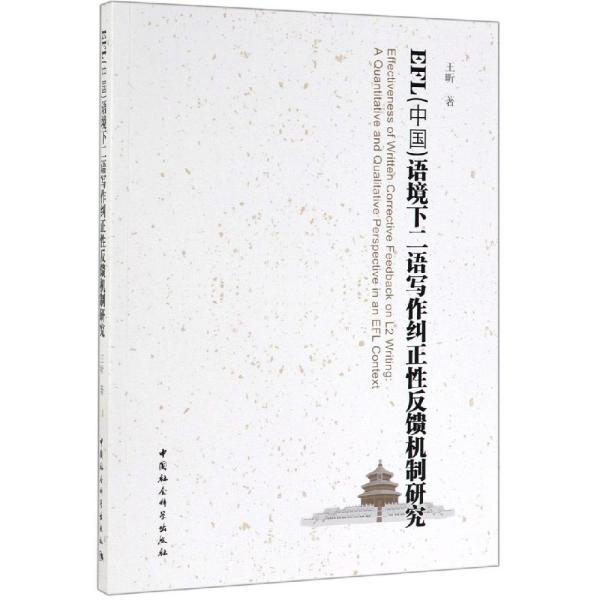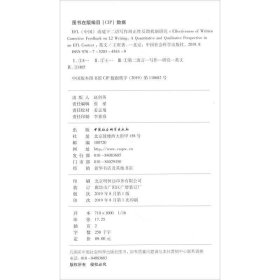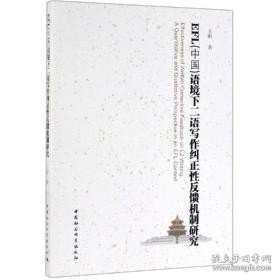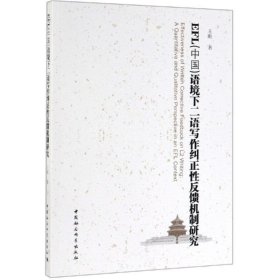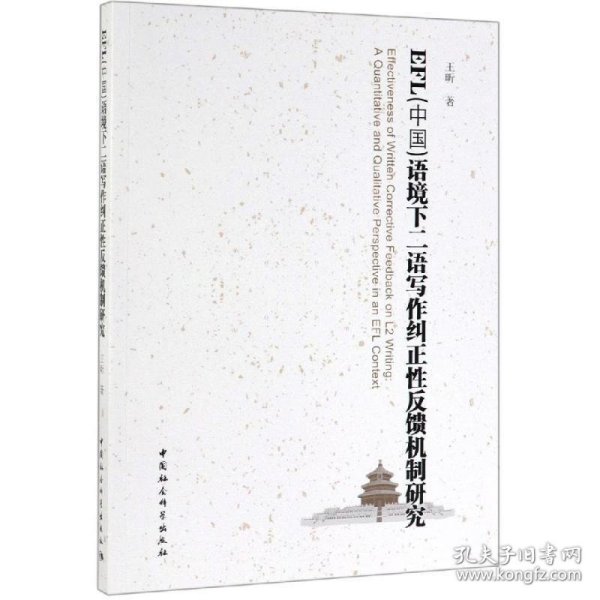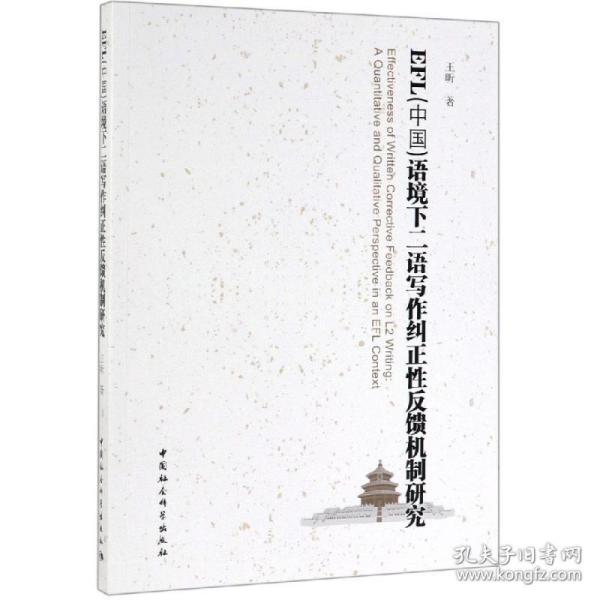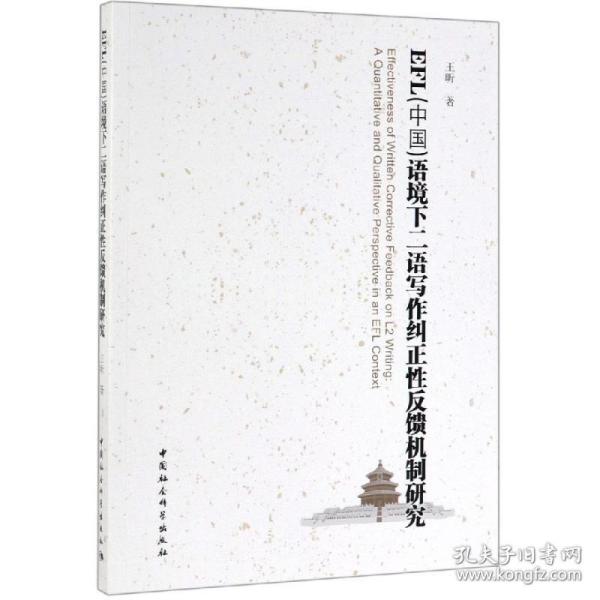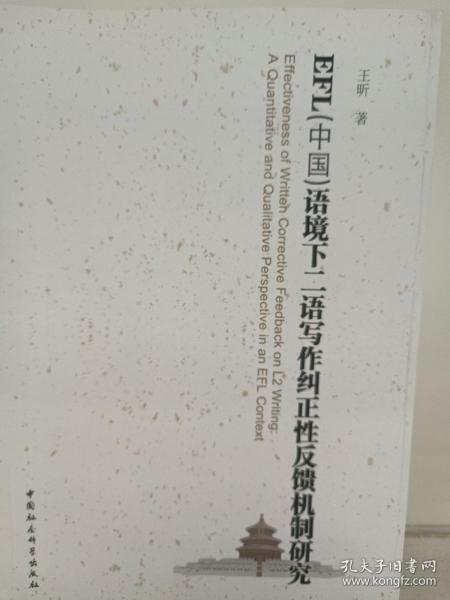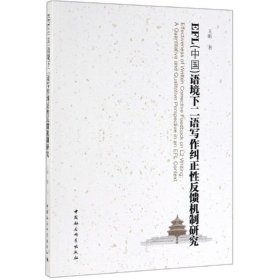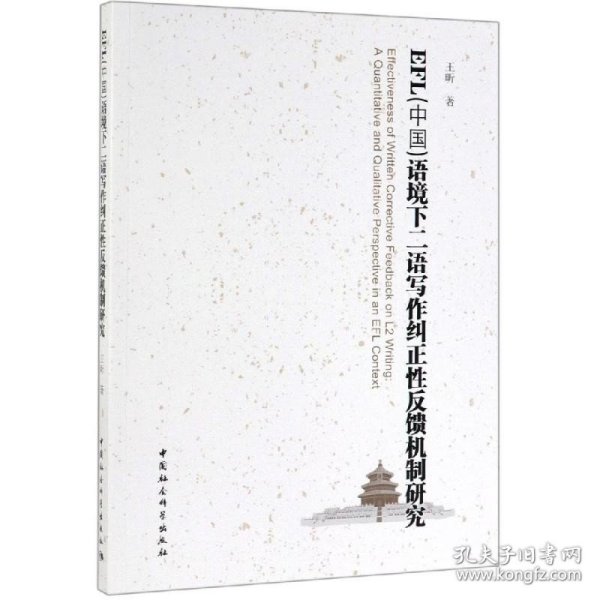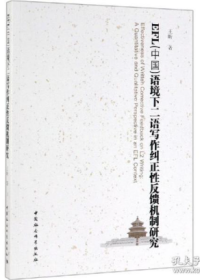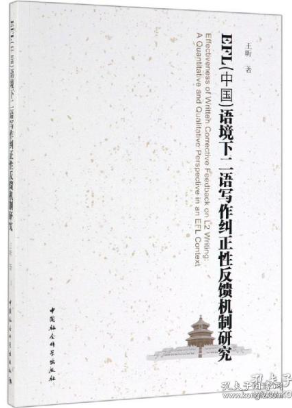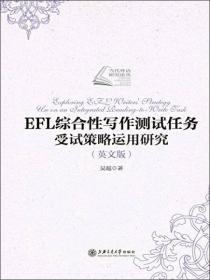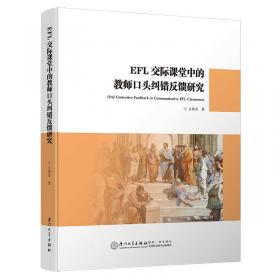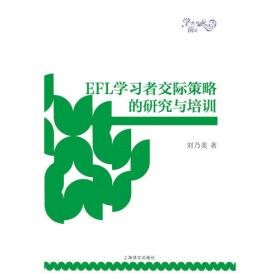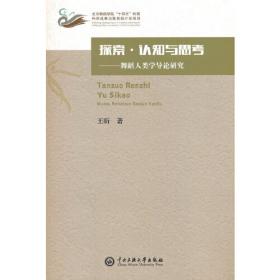EFL(中国)语境下二语写作纠正性反馈机制研究
出版时间:
2019-08
版次:
1
ISBN:
9787520345439
定价:
89.00
装帧:
平装
开本:
16开
纸张:
胶版纸
页数:
256页
2人买过
-
国内外相关学者在二语习得和二语写作领域对纠正性反馈问题进行了持续研究。然而,对于纠正性反馈的效应,迄今仍未形成一致性结论。纠正性反馈的参与主体具有“双元性”,即考虑到纠正性反馈的特性,有效的纠正反馈需要教学者和学习者的共同参与。这意味着参与双方的偏好、经验和积极性等个体特征对纠正性反馈的效果具有明显影响。显然,二语教学者和学习者对纠正性反馈的认知偏差实际上导致了纠正性反馈研究和实践的困境:一方面,纠正性反馈具有认知的同质性,所有参与者都认可其在写作精确度提高方面的积极作用;另一方面,纠正性反馈具有认知的异质性,不同参与者对其影响路径和程度的认知存在明显个体性;这一共性与个性的矛盾加剧了纠正性反馈研究的困难性。 王昕,山东青岛人,2009年获青岛大学英语学士学位,2013年获美国北亚利桑那大学应用语言学和第二外语教学双硕士学位,2017年获美国北亚利桑那大学教育博士学位。于2007年被选为交换生公派赴美国密苏里州立大学交流学习。美国应用语言学,语料库语言学和二语写作协会成员。现为青岛大学外语学院助理教授。主要研究领域为应用语言学、语料库语言学、二语习得。长期跟踪应用语言学领域研究动态,具有扎实的研究基础和研究经验。公开发表国际学术期刊论文及会议论文10余篇,参与国内外人文社科项目5项。目前主要从事口译及学术论文写作的教学与研究工作。 Chapter 1:lntroduction
1.1 Context Analysis
1. 1. 1 EFL Context in China
1.1.2 Context of the Study
1.2 Outline of the Study
Chapter 2: Literature Review
2.1 Form-focused Instruction(FFI)in SLA
2.1.1 Naturalistic Exposure vs. Formal Instruction
2.1.2 Focus on Forms(FonFs)vs. Focus on Form( FonF)
2.1.3 Explicit vs. Implicit Knowledge and Learning
2.1.4 The Role of Grammar Instruction in Pedagogy
2.2 Positive Evidence vs. Negative Evidence in SIA
2.3 Corrective Feedback in 12 Writing
2.3.1 Positions on Corrective Feedback in 12 Learning
2.3.1.1 Arguments against Corrective Feedback
2.3.1.2 Arguments for Corrective Feedback
2.3.1.3 Types of Corrective Feedback
2.3.2 Perceptions of Corrective Feedback in L2 Learning
2.3.2.1 Negative Perceptions
……
Chapter 3:Methodology
Chapter 4:Quantitative Results: Pretest, Posttest and Delayed Posttest
Chapter 5: Mixed Methods Results: Questionnaires
Chapter 6: Qualitative Results: Interviews and Classroom Observation
Chapter 7 : Discussion
Chapter 8:Implications, Recommendations and
Conclusion
References
Appendix A Grading Criteria for Linguistic Accuracy
Appendix B Test Prompts
Appendix C Questionnaires
Appendix D Interview Questions in Chinese
Appendix E Examples of Student Errors Across Pretest,
Posttest, and Delayed Posttest in the Three Groups
Appendix F Text Lengths
Appendix G Examples of Students' Responses to the
Open-ended Questions In Questionnaire One
Appendix H Abbreviations
-
内容简介:
国内外相关学者在二语习得和二语写作领域对纠正性反馈问题进行了持续研究。然而,对于纠正性反馈的效应,迄今仍未形成一致性结论。纠正性反馈的参与主体具有“双元性”,即考虑到纠正性反馈的特性,有效的纠正反馈需要教学者和学习者的共同参与。这意味着参与双方的偏好、经验和积极性等个体特征对纠正性反馈的效果具有明显影响。显然,二语教学者和学习者对纠正性反馈的认知偏差实际上导致了纠正性反馈研究和实践的困境:一方面,纠正性反馈具有认知的同质性,所有参与者都认可其在写作精确度提高方面的积极作用;另一方面,纠正性反馈具有认知的异质性,不同参与者对其影响路径和程度的认知存在明显个体性;这一共性与个性的矛盾加剧了纠正性反馈研究的困难性。
-
作者简介:
王昕,山东青岛人,2009年获青岛大学英语学士学位,2013年获美国北亚利桑那大学应用语言学和第二外语教学双硕士学位,2017年获美国北亚利桑那大学教育博士学位。于2007年被选为交换生公派赴美国密苏里州立大学交流学习。美国应用语言学,语料库语言学和二语写作协会成员。现为青岛大学外语学院助理教授。主要研究领域为应用语言学、语料库语言学、二语习得。长期跟踪应用语言学领域研究动态,具有扎实的研究基础和研究经验。公开发表国际学术期刊论文及会议论文10余篇,参与国内外人文社科项目5项。目前主要从事口译及学术论文写作的教学与研究工作。
-
目录:
Chapter 1:lntroduction
1.1 Context Analysis
1. 1. 1 EFL Context in China
1.1.2 Context of the Study
1.2 Outline of the Study
Chapter 2: Literature Review
2.1 Form-focused Instruction(FFI)in SLA
2.1.1 Naturalistic Exposure vs. Formal Instruction
2.1.2 Focus on Forms(FonFs)vs. Focus on Form( FonF)
2.1.3 Explicit vs. Implicit Knowledge and Learning
2.1.4 The Role of Grammar Instruction in Pedagogy
2.2 Positive Evidence vs. Negative Evidence in SIA
2.3 Corrective Feedback in 12 Writing
2.3.1 Positions on Corrective Feedback in 12 Learning
2.3.1.1 Arguments against Corrective Feedback
2.3.1.2 Arguments for Corrective Feedback
2.3.1.3 Types of Corrective Feedback
2.3.2 Perceptions of Corrective Feedback in L2 Learning
2.3.2.1 Negative Perceptions
……
Chapter 3:Methodology
Chapter 4:Quantitative Results: Pretest, Posttest and Delayed Posttest
Chapter 5: Mixed Methods Results: Questionnaires
Chapter 6: Qualitative Results: Interviews and Classroom Observation
Chapter 7 : Discussion
Chapter 8:Implications, Recommendations and
Conclusion
References
Appendix A Grading Criteria for Linguistic Accuracy
Appendix B Test Prompts
Appendix C Questionnaires
Appendix D Interview Questions in Chinese
Appendix E Examples of Student Errors Across Pretest,
Posttest, and Delayed Posttest in the Three Groups
Appendix F Text Lengths
Appendix G Examples of Students' Responses to the
Open-ended Questions In Questionnaire One
Appendix H Abbreviations
查看详情
-
全新
四川省成都市
平均发货58小时
成功完成率82.25%
-
全新
江苏省无锡市
平均发货14小时
成功完成率86.43%
-
全新
江苏省无锡市
平均发货8小时
成功完成率96.15%
-
全新
四川省成都市
平均发货15小时
成功完成率90.97%
-
全新
广东省广州市
平均发货35小时
成功完成率70.54%
-
全新
江苏省南京市
平均发货14小时
成功完成率82.21%
-
全新
河北省保定市
平均发货18小时
成功完成率81.55%
-
九五品
北京市东城区
平均发货8小时
成功完成率95.56%
-
九五品
河北省保定市
平均发货28小时
成功完成率88.38%
-
全新
广东省广州市
平均发货16小时
成功完成率89.81%
-
全新
广东省广州市
平均发货18小时
成功完成率88.48%
-
全新
广东省广州市
平均发货18小时
成功完成率86.64%
-
九五品
北京市朝阳区
平均发货29小时
成功完成率86.25%
-
九五品
北京市东城区
平均发货29小时
成功完成率84.08%
-
全新
北京市西城区
平均发货23小时
成功完成率93.57%
-
九品
北京市丰台区
平均发货7小时
成功完成率96.06%
-
全新
河北省保定市
平均发货14小时
成功完成率91.07%
-
全新
天津市河东区
平均发货24小时
成功完成率90.06%
-
全新
江苏省无锡市
平均发货9小时
成功完成率94.35%
-
九五品
江苏省南京市
平均发货15小时
成功完成率92.36%
-
九五品
天津市河西区
平均发货27小时
成功完成率88.24%
-
全新
北京市朝阳区
平均发货13小时
成功完成率93.01%
-
全新
河北省保定市
平均发货5小时
成功完成率86.23%
-
全新
河北省保定市
平均发货5小时
成功完成率83.29%
-
全新
-
全新
江苏省南京市
平均发货21小时
成功完成率91.67%
-
九品
北京市海淀区
平均发货24小时
成功完成率87.51%
-
全新
天津市津南区
平均发货13小时
成功完成率85.23%
-
全新
天津市和平区
平均发货23小时
成功完成率80.02%
-
九五品
北京市西城区
平均发货16小时
成功完成率88.61%

 占位居中
占位居中





